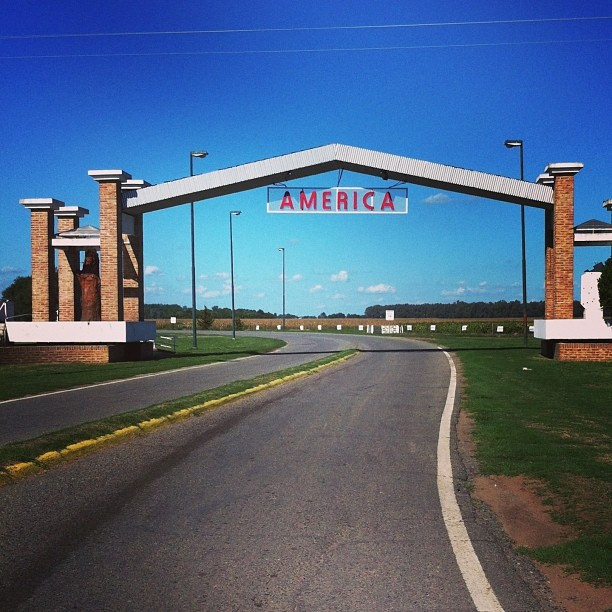After leaving Punta Alta, we traversed Argentina from its Atlantic Coast to its Western edge, in a matter of days. This meant crossing the low-lying plains of La Pampa. It felt like driving through the Great Plains on any rural highway: nothing to see, nowhere to turn, just straight and flat.

That said, this area is not without its charm, as we came across some very bizarre finds. In addition to The Atlantis of Argentina, we also encountered a very strange creature at Lake Epecuen:

No, Milo isn’t that strange…it was FLAMINGOS! I couldn’t get a decent photo from the muddy edge, but they were there! Lots of them.

Apparently the flamingos are just seasonal residents, with their numbers peaking earlier in December, when the campground manager told us at the lake is just teeming with the pink birds.
Another weird thing we randomly encountered was in the town of Potrero de Los Funes, just outside of San Luis. We were driving around in the rain looking for the campsites around the lake, when all of a sudden we found ourselves on a racetrack.

Not only did this town decide to build a racetrack, but they decided that when it wasn’t being used by racers, that it should be used as a normal roadway. The temptation to try and push the van to 75 miles an hour (let’s be honest) was tempered by the rain.
Unlike the major highways in Mexico and Central America, which drive right through cities large and small, the highways in Argentina–at least in this part of the country–pass far away from most urban centers. Visiting the towns means exiting the highway and driving 20 or 30 kilometers into the town. The towns, for the most part, are pleasant and seem very sleepy, especially since we have a tendency to arrive during siesta. They all seem like idyllic places that you would imagine in small-town America in the 50s. Inevitably we see children on bicycles, a lovely central square, and people of all ages eating ice cream. In general, I would describe Argentina thus far as having a lifestyle from the 50s, an economy from the 60s, architecture from the 70s, music from the 80s, fashion from the 90s, and technology from the aughts. At least, it sounds comprehensive this way.

Driving through this part of the country is easy. Food is plentiful and cheap, gas is easy to find, and we always have our pick of campgrounds. Argentina is the first country we have visited where we find ourselves camping not with other overlanders but with Argentines. The Argentines, it seem, have a passion for camping, and every campground is enormous and well equipped with enough grills and picnic tables for 1,000 Argentines to consume their requisite 1,000 kilos of meat. Also, every gas station sells ice, so we are able to always acquire these two road necessities at once.

To our surprise, many of the campgrounds do not allow dogs. This is surprising because Argentina–like most of Latin America–has proven to be very dog-friendly (or at the very least, indifferent). Luckily, there are so many campgrounds that we are always able to find one that will accommodate us, even if it’s not our first choice.

After days of driving through the pampas, it was such a welcome sight to see the Andes.

More photos from a month of siestas at limpire.

My husband and I met Juan on a flight to Chile. So fun to see and read about your fantastic adventure. Thanks for sharing. I am still laughing at Juan’s quote about the cry for help from the kitchen of those struggling with dessert. I brought home small pots of dulce de leche to share with our girls. Everytime I see this Argentinian treat a little chortle bursts out and surprises me. Thanks Juan.
These photos are off the hook. I hope your CA travels were good and worth it and I wish you both so much luck in your lives together.
Hi Lynn, it was great to meet you guys!
The quote about dulce de leche doesn’t belong to me, but to this great writer and observer of Argentina:
http://idlewords.com/2006/04/argentina_on_two_steaks_a_day.htm
Read the whole thing, it is worth it!
Great photos , keep them coming
Is that Argentina done and onto Chile now?